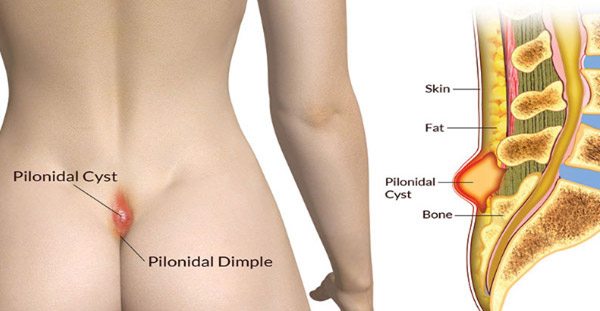Call Us : +91-129-431-0477 | Mail Us : infogoyalhospital@gmail.com
Pilonidal sinus (PNS)
Pilonidal sinus (PNS) or pilonidal cyst is a tiny cleft, tunnel, or hole that occurs in the skin at the top of the buttocks. It can fill with pus or fluid leading to the growth of an abscess or cyst. A pilonidal cyst often holds debris, hair, and dirt. It can lead to unbearable discomfort and can usually become infected. When infected, it can exude blood and pus and harbor a nasty smell. Pilonidal sinus (PNS) is a disease that mainly affects males and is typical in immature adults. It’s likewise quite normal in people who sit for a longer time, for example, cab drivers, office employees, etc.
Complications That Can Happen If Not Treated On Time
Several complications can happen due to Pilonidal sinus (PNS) or pilonidal cyst. They comprise wound infection and a recurrence of the Pilonidal sinus even after the operation.
Indications that the wound is infected comprise:
Causes of Pilonidal sinus (PNS)
Even experts haven't discovered the actual causes of pilonidal sinus yet. But, they do comprehend that ingrown hairs seen in the furrows of the buttocks can engender a skin infection that leads to a pilonidal cyst to grow. If not treated on time, a pilonidal sinus can potentially result in a sinus cavity or an abscess. Pilonidal sinuses are pretty normal in males because they have more hairs than females. Sitting for a long time can likewise raise the possibility of a pilonidal sinus.

Symptoms of Pilonidal Sinus
Symptoms of pilonidal sinus can include:
Diagnosis & Treatment of Pilonidal Sinus
Your doctor will begin by providing you with a complete physical test to diagnose pilonidal sinus. Throughout the exam, the doctor will inspect the creases of the buttocks for symptoms of a pilonidal cyst. In case you have a pilonidal cyst, it should be perceptible to the bare eyes. The doctor may find what appears as an oozing cyst or a pimple. If that is the case, then they will ask you some questions, such as:
In rare cases, the doctor will order an MRI or a CT to examine for any sinus cavities (small holes) which might have grown beneath the surface of the skin.
Treatment options for an infected pilonidal sinus will be based on:
Pilonidal cyst abscess usually requires treatment with antibiotics. The pus inside it will likewise have to be emptied. Several treatment alternatives are available for a pilonidal sinus that reoccur, bleeds, aches, and leaks.
In many instances, you will be suggested painkillers like anti-inflammatories or paracetamol to relieve discomfort and bulge.
Based on the acuteness of the signs, you may or may not require surgery to treat the pilonidal cyst. Besides surgery, there are some other treatment alternatives available too such as:
Surgical Alternatives To Treat Pilonidal Sinus
In case you are undergoing a recurring Pilonidal sinus your doctor will suggest a surgical method. You will be initially provided an anesthetic. Later, the surgeon will spread the lesions, dismissing all the debris and pus from it. Then the surgeon will sew the wounds. After the surgery, the doctor will tell you how to change the bandages and suggest you to shave the area so that the hair will get stop from growing into the wound.
Foods/Diets To Follow After Pilonidal Sinus
After a pilonidal sinus surgery/treatment, it is inevitable for you to eat a nutritious diet with a medium amount of protein and a large amount of fiber and different nutrients. Protein promotes recovery and skin renewal in the body; moreover, fiber helps in digestion to prevent straining while bowel movements.